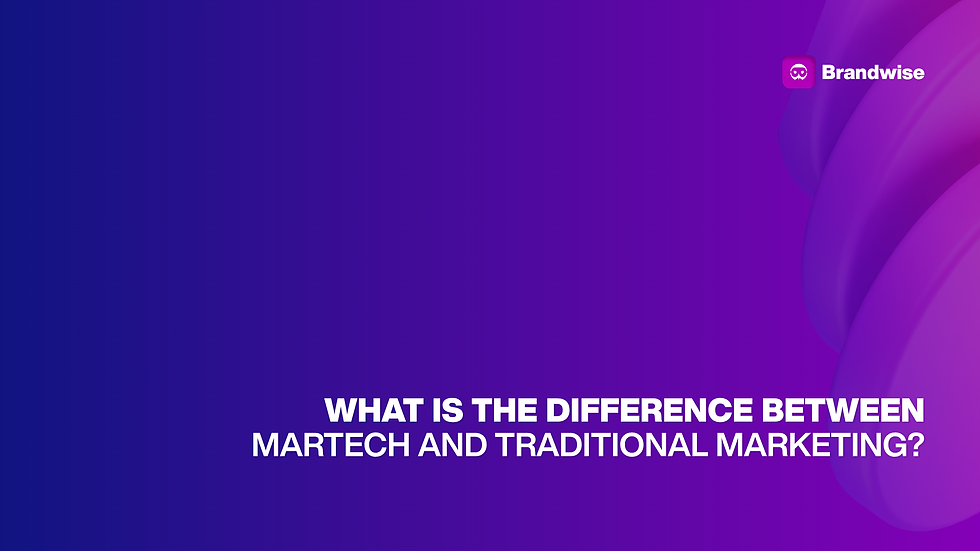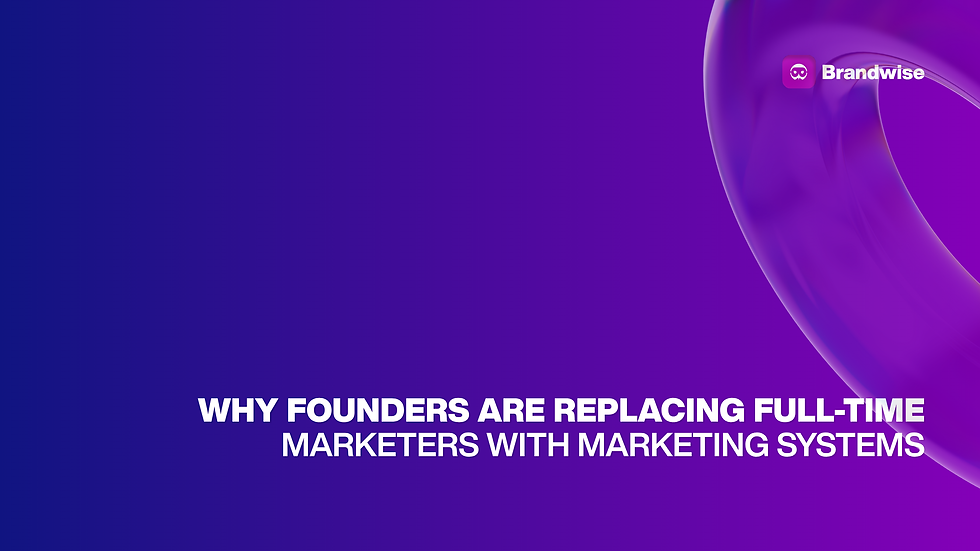The Ultimate Guide to Marketing Automation
- Luka Javakhishvili

- Jul 2
- 6 min read

If you're still juggling 15 tabs, manually scheduling social posts, and writing out every single follow-up email yourself, stop. It's 2025, and if your marketing strategy isn't automated, you're already behind.
But here's the thing: marketing automation isn't just about saving time anymore. It's about improving performance, optimizing budget, and giving your audience the experience they expect.
In this guide, I'll break down what marketing automation really means in 2025, what it can do for your business, the tools worth your time, and the strategy to actually make it all work. No fluff, no overhype—just what you need to know to start doing marketing smarter.
Table of Contents:
What Is Marketing Automation?
Marketing automation is the use of technology to handle repetitive marketing tasks, campaigns, and processes across multiple channels. Think beyond email sequences.
Today, automation touches nearly every customer interaction and backend process.
It now includes:
Predictive content delivery: AI analyzes user behavior and delivers the right message or offer at the optimal time.
AI-powered lead scoring: Automatically rank leads based on engagement, demographics, and purchase intent.
Dynamic ad retargeting: Show tailored ads to users based on what they viewed, clicked, or abandoned.
Hyper-personalized drip campaigns: Email and SMS sequences triggered by behavior, tailored for every user segment.
Automated CRM updates and behavioral segmentation: Keep customer data clean, current, and organized without lifting a finger.
The goal? Streamline your team’s workload while improving the customer journey, increasing conversion rates, and maximizing your marketing ROI.
Why It Matters More Than Ever
We’re not just automating to save time. We’re automating to compete and scale. Here's why automation is absolutely non-negotiable:
Cross-channel complexity: The average marketer now operates on more than eight platforms—email, SMS, social, ads, web, apps, and more. Automation ensures you stay consistent, cohesive, and efficient without overwhelming your team.
Customer expectations: Audiences expect real-time, personalized experiences at every touchpoint. If you're not using automation, you're likely delivering a fragmented experience.
Budgets are tight: Marketing budgets have dropped to roughly 7.7% of company revenue. That means every task, tool, and tactic must justify its ROI. Automation helps you do more with less.
Data is messy: Leads come in from everywhere, and messy data creates poor decisions. Automation tools clean, unify, and activate your data to deliver smarter, more informed campaigns.
Benefits You Should Actually Care About
Forget fluffy “brand synergy” talk—here’s what marketing automation actually delivers when done right:
Lead Generation & Qualification: With real-time automation, you can instantly engage website visitors, capture their info, qualify them based on interaction data, and send them directly to your CRM or sales team—automatically.
Higher Conversions: Instead of generic blasts, use automation to create highly personalized customer journeys. Behavioral triggers ensure each message is timely, relevant, and conversion-focused.
Time-Saving: Say goodbye to repetitive, manual tasks like follow-up emails, spreadsheet segmentation, or post scheduling. Automation frees up your team to focus on strategy, creativity, and growth.
Better Insights: Real-time dashboards and reporting help you identify what’s driving results and where you're leaking ROI. Adjust faster, scale smarter.
Stronger Retention: Keep your customers engaged with lifecycle automations—from onboarding sequences to reactivation flows. Nurture relationships long after the first conversion.
Top Tools in 2025 Worth Your Attention
Whether you’re just setting up your stack or fine-tuning your growth engine, these tools are leading the pack in 2025. The key is not using more tools—it’s using the right ones that integrate, scale, and actually solve your problems.
HubSpot
Your go-to if you want one platform that does it all—CRM, email, landing pages, lead scoring, and reporting. Great for small to midsize teams that want power and ease. Why it stands out: Native integrations, great UI, and no need for a dev team to get started.
Marketo (by Adobe)
Enterprise-level automation with deep segmentation, advanced personalization, and full-funnel analytics. Best for large teams managing multiple audience types or regions. Why it stands out: Multi-touch attribution, predictive content, and seamless Adobe suite integration.
ActiveCampaign
Powerful automation without the enterprise-level bloat. Offers email, SMS, site tracking, CRM features, and complex logic in an intuitive interface.
Why it stands out: Conditional logic that feels accessible, not overwhelming.
Customer.io
Built for product-led teams. If your platform has lots of events, user paths, or behaviors to track, this is your tool. Why it stands out: Real-time segmentation, flexible API, and granular control over every user journey.
GetResponse
Simple, ecommerce-friendly workflows with strong email and landing page capabilities. A great choice for DTC brands or startups focused on quick conversion. Why it stands out: Affordable automation for lean teams, plus built-in webinar tools.
Omneky
Let AI build and test your ads on autopilot. Perfect for performance marketers tired of A/B testing everything manually.
Why it stands out: Creative generation + automated multivariate testing = fast, data-backed wins.
ChatGPT + Zapier
Content meets automation. Use ChatGPT to generate content, and connect it via Zapier to send emails, update CRMs, trigger Slack messages, and more—without touching a line of code.
Why it stands out: Hands-free workflows. Great for content-heavy teams or solo operators.
The Automation Workflow Blueprint
You don’t need a hundred flows. You need a repeatable, scalable structure. Here’s the automation process that actually works.
1. Set Clear Goals
Start with outcomes, not tools.
Are you trying to increase trial-to-paid conversions?
Reduce cart abandonment?
Improve customer retention?
Your goals will define your flows, not the other way around.
2. Map Your Funnel
Zoom out. Where are users leaking out of your funnel?
Where do they ghost you?
Where do they open but not click?
Where do they churn?
This step gives context to your automation, so you're solving friction, not just blasting emails.
3. Segment Ruthlessly
Forget guessing. Let behavior tell you who’s ready, who’s engaged, and who’s gone cold.
Visited the pricing page 3+ times = hot lead
Opened but didn’t click = nurture
Purchased once, no repeat in 30 days = re-engagement
Treat actions like signals. That’s where the money is.
4. Build Triggers & Flows
Every meaningful user action should have a reaction.
Downloaded a guide → trigger follow-up sequence
Viewed demo page → invite to schedule
Inactive for 14 days → send reactivation offer
Don’t overbuild. Start with key lifecycle points and expand based on what’s working.
5. Test Relentlessly
Guessing is expensive. A/B test:
Subject lines
Send times
CTAs
Landing page variants
Even small tweaks can double conversion rates. Let data do the deciding.
6. Measure & Optimize
Look at your numbers every week. What’s stuck? What’s scaling?
Track opens, clicks, conversion rates
Segment by source/channel
Kill underperformers, double down on what’s working
Automation isn’t “set it and forget it”—it’s set it, track it, tweak it, scale it.
Watch Out for These Pitfalls
Even the best tools can backfire if you skip the basics. Here are the most common mistakes to avoid:
Bad Data = Bad Decisions
If your data is outdated, duplicated, or just flat-out wrong, automation won’t help—it’ll amplify the problem. Garbage in, garbage out.→ Fix it: Schedule regular data audits. Use validation rules. Integrate your platforms to reduce manual entry errors.
Over-Automation Kills Trust
Just because you can automate everything doesn’t mean you should. If every message is templated and transactional, your brand starts to feel cold and lifeless.→ Fix it: Add human checkpoints. Personalize with context, not just first names. Balance automation with empathy.
No Content Strategy = No Traction
Automation is a delivery system, not the message. Without content mapped to the customer journey, you’re just spamming people with noise.→ Fix it: Build a content map. Align every workflow with value-driven messaging. Don’t automate for automation’s sake.
Disconnected Systems = Missed Opportunities
Your email tool, CRM, CMS, and ad platforms need to talk to each other. Otherwise, you’re flying blind, missing triggers, and fragmenting your user experience.→ Fix it: Use integrations (native or via tools like Zapier). Prioritize platforms that sync cleanly across your stack.
Conclusion
Marketing automation in 2025 isn’t optional—it’s the backbone of modern, scalable marketing. But let’s be clear: it’s not a silver bullet. It’s not a one-click solution or a “set it and forget it” shortcut. It’s a system—and like any system, it needs structure, clarity, and ongoing care.
It only works when your goals are clearly defined, your data is accurate and actionable, your content speaks directly to your audience, your tools are integrated across platforms, and your team is committed to reviewing and refining weekly.
Get that combination right, and automation becomes more than just a time-saver. It becomes your growth engine. You won’t be chasing ROI—you’ll be building it into every campaign by design.
Discover Brandwise's Digital Marketing Solutions
At Brandwise, we specialize in providing comprehensive digital marketing solutions tailored to your business needs. Our services cover branding and identity creation, website development, social media management, content strategy, SEO, paid advertising, data analysis, and more.
Whether you're looking to build your online presence or optimize your marketing strategies, we have the expertise to help you succeed.
If you're ready to take the next step and make an informed decision for your next project, click the button to see our plans.
For more inspiration and to see our innovative projects, visit our showcase.



